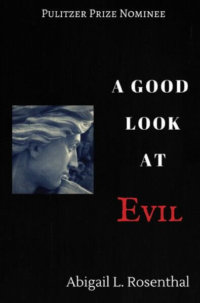A Good Look at Evil

A Good Look at Evil. Abigail L. Rosenthal. Eugene, OR: Wipf & Stock, 1987.
Pulitzer Prize-nominated, Abigail Rosenthal’s A Good Look at Evil is an exploration of the philosophical problem evil from a literary perspective: What is evil? How can we recognize it? And how can we resist it? After reviewing the philosophical and psychological literature on the question of evil, Rosenthal finds the answers unsatisfactory and therefore adopts a literary approach to the question. By doing so, Rosenthal shows what evil is and how it is a perennial threat to us.
In chapter one Rosenthal contends that we live our lives according to an ideal, rational story. Rationality is not ruthless consistency for Rosenthal (e.g., to act with maximal efficiency for a predetermined goal) but the ability to look backward and forward in our lives to find “an ideal thread of plot in one’s life” (6). It is to adopt an attitude of lifelong curiosity towards the meanings of our lives instead of uncovering a definitive answer or indulge in non-rational ways. This approach to life is ordinary, patient, and reflective, as opposed to dramatic, immediate, and intuitive. By making our stories rational, we are able to resist our lives from becoming senseless, tragic, or arbitrary, as some deconstructionists would have it.
According to Rosenthal, there are two main ways our stories can be derailed: you no longer see further in your own story or your story is thwarted. The former is banality, while the latter Rosenthal labels evil. In chapter two, she explains that thwarting our story is evil because it violates our freedom to live up to our ideal. An example of this is the encounter of two cultures with different concepts of what constitutes good and evil. Rejecting cultural relativism, Rosenthal contends that people will recognize if their culture is not able to deliver on its promises and confirm its metaphysical premises if it encounters a rival and superior culture. The options for such a people are to be demoralized, retreat in isolation, or incorporate the other culture’s views and techniques into their own metaphysical system.
Chapters three and four examine pure typologies of evil in individuals and institutions. Chapter three focuses on the seducer who promises an attractive and pleasant story for the other. It is a charming story (or, a life of redemption for women who desire to reform him) but in reality it is only a mirage vision of himself with his victims losing the purpose in their lives for nothing in return. Chapter four looks at the sell-out who conforms to a clear-cut and morally wrong consensus of an institution. To conform to such a consensus is to reduce yourself to your craftsmanship, job, or techne, and deny yourself a larger story. The result of this institutional failure spills over into the public where all citizens suffer from it.
Chapter five looks at genocide as a type of evil where an entire people’s story is thwarted. To understand this type of evil, greater discernment is required – whether genocide is impulsive, motivated by material gain, perceived as part of one’s corporate identity, or driven by ideology. The ideologue is especially evil because he has given up on his story and the stories of others, thereby authorizing himself to do anything. In chapter seven Rosenthal examines how the Nazis think of their own stories as an example of ideological thinking. What we find is that the evilness of genocide is not only the slaughter of a people but to mutilate their story so it will be misinterpreted for posterity.
The public intellectual consequently has a role to play to preserve those stories that are true and prevent the distortions of those that are false. Rosenthal reviews Arendt’s Eichmann in Jerusalem as an example of how a public intellectual has failed in her judgment and, in turn, damages her own story. Rosenthal refutes Arendt’s numerous claims about the trial, such as the court not being impartial, Eichmann was not guilty of criminal intent beyond a reasonable doubt, and that victims of the Holocaust were complicit. Furthermore, as argued in chapter eight, her affair with Heidegger and her failure to address the inconsistencies in her own thinking undermines or “spoils” her story about Eichmann’s trial, the Holocaust, and role as a public intellectual.
The concluding chapter explores how we live our lives as stories, with Rosenthal providing an autobiographical account as a template for us. In the construction of our stories, we see that we are relational beings and cannot live in isolation: we are defined by our relationship (or non-relationship) with God, our friends and family, our vocations, and our moral values. Rosenthal lists four possible moral values: Cynical, Stoic, therapeutic, or the Pilgrim on the way to God who lives by “intelligent hope.” The Pilgrim paradigm reminds us that our lives are not just ethical or psychological but also literary and that the closer we know God the more God is a co-author of our stories.
A Good Look at Evil is not only an examination of evil but propose a new way to think about our own lives. By adopting a literary approach to a philosophical question, Rosenthal has provided genuine insight into a problem that has befuddled thinkers for ages. Evil is not an abstract concept but a lived reality and situation in which we encounter. If you wish to understand evil as well as to know how to live your life, A Good Look at Evil is a perfect way to begin writing your own story.
Barry Cooper’s review of the same book is available here.




